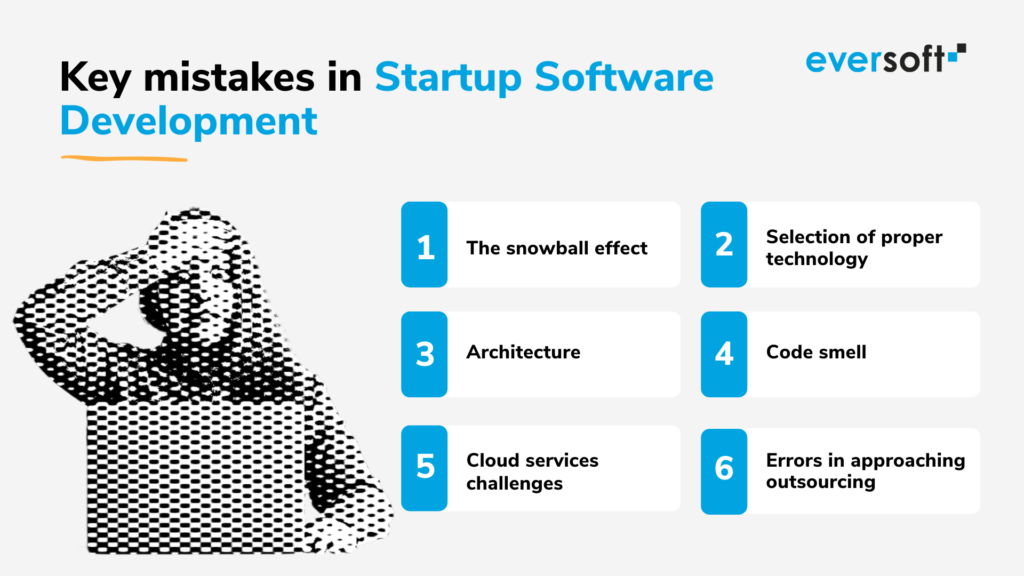Key mistakes in Startup Software Development
According to „The Ultimate Startup Failure Rate Report 2020” approximately 137 thousand enterprises is launched daily. On a larger scale – yearly, the number amounts to 50 million. Unfortunately, 90% of them achieve no success. However, one should remember, that a large contribution to the failure (or success!) of the startups, may be made by the quality of the software that they develop (or endorse).
Key mistakes in Startup Software Development
Table of contents:
1. The snowball effect
The most common mistakes that may affect the fate of the entire endeavor, result from the very specifics of startups. Modest budget, teams scattered across the world, with huge ambitions and long-range goals. Additionally, a significant role is played by the shareholders’ pressure, who demand large returns on investments, without considering the difficulties faced by the developers.
Furthermore, rush and pressure do not help to document a dynamically expanding project systematically and meticulously, and this may prove a challenge during onboarding new developers. As demonstrated, here we are dealing with the snowball effect, where one issue leads to another.
2. Selection of proper technology
All that glitters is not gold – especially in selection of proper technology. Startup dynamics affect the adverse selection of tools for long-range goals. On numerous occasions, tools with slightly less striking parameters, but with a well grounded position, specialised applications and solid documentation will be prove to be better than services, which quickly acquire popularity, but come and go in a blink of an eye.
Surely, currently few younger developers remember Adobe Integrated Runtime – an environment that was supposed to allow the same applications (by the way – created in Flash or AJAX, which are currently fading into obscurity) on various platforms. The same obscurity touched the concept of the Universal Windows Platform, which – while solely within the scope of Microsoft systems, but still – was supposed to be able to create one application for the needs of various classes of devices.
In comparison, Java which celebrates its 25th birthday, fulfills both these tasks, and there are no signs of it fading away. Additionally, the issue of adjusting technologies to employment market conditions is important, so that the lack of appropriately specialized programmers does not become an issue. At times, the new and promising languages, as Rust or Go recently, can allow finding experienced experts quickly. In comparison, one may once again point at Java with its enormous and constantly expanding base, and relatively high accessibility to experts on various levels.
The rest of the article is available below free e-book form.

3. Architecture
Regardless of whether the startup decides to develop software in-house or chooses outsourcing, the awareness regarding software architecture is essential, which is often omitted. Enumerated micro-services shall not always prove to be the best solutions, and the structure of subsequent software components will have to be adjusted to the goals, that the startup intends to achieve, and even be determined by these goals. The architecture may be selected not only regarding the practical applications of the designed software, but also business goals. A different architecture will be chosen, when we are in a rush, and a different one where we are aiming at performance or scalability of the solution.
In result, the aforementioned micro-services will meet the requirements of websites with small and independent modules, or in dynamically expanding browser applications. Surely, the discussion regarding the adopted architecture is one of the most important decisions at the initial stage of software design, regardless of whether we speak of a minor start-up or a large organization.
In scenarios, where we are dealing with a complicated and not organized environment, which will additionally require scaling, the event-driven architecture will prove to be a better choice. In other solutions, e.g. where a clear division of roles or the ease of maintenance works, or localization tasks are necessary, the tier architecture will prove to be the best. There is a plethora of possible choices, however, the choice must be deliberate.
4. Code smell
The issue is not only related to startups, however, it may be a nightmare for them and their customers. Even the selection of best technologies, frameworks, IDE and other tools, will not translate to the high quality of the software created by startups. While a good compiler is able to deal with detecting errors in code, it will be unable to protect the endeavor from code smell – bad decisions during the code development process, that – despite not being errors per se – cause the software to work slow or, even, be unusable. Repetitions of entire blocs of code, bloaters, too long methods and too large classes – all these shortcomings may cause the startup to fail.
5. Cloud services challenges
Without a doubt, the expanding portfolios of such service providers as Amazon Web Services or Microsoft Azure are an appealing treat for every startup, however, lack of experience with similar tools may yield grave consequences to the budget of the entire operation. Particularly, as the providers do not shy away from applying payments that are not obvious from the start, while the appetite for such products is growing in time, also in relation to the automation of tasks.
Therefore, a common case, is a phenomenon, that the customers are not taking full advantage of the potential of services, and the creation of expanded environments, that are not well-optimized for startups. Many assume that tools allowing to automate works with cloud infrastructure, used by providers themselves, are a solution to all problems.
However, optimal (also financially), adoption of resources taken from Amazon, Microsoft, or Google, is a separate specialization, and it will not be an exaggeration to create a separate position for a cloud governance specialist, who, during the work of the team would dedicate his efforts solely (or at least partially) to the optimization of cloud use.
6. Errors in approaching outsourcing
Obviously, a large portion of the aforementioned issues may be evaded by startups, through deciding on outsourcing the entire software development process. The most frequent is related to the issues regarding the proper selection of collaboration model, that would benefit both the execution of operations, as well as, long lasting goals of startups.
Developing an efficient model of collaboration between the in-house software development team and external contractors, an appropriate distinction between competencies and functions, as well as, efficient and responsive communication, are additional challenges, which the startups must face.

7. Final thoughts on Key mistakes in Startup Software Development
Essentially, the challenges and issues that startups must face during software development are not much different from the complications faced by any team that launches a fresh project.
However, there is a large difference regarding the grounds on which these challenges are placed. In terms of startups, which must often go far in terms of financial optimization, and be under the pressure of competition, investors and users, all mistakes and shortcomings already at the initial stages may – in a long-term scenario – prove critical. Therefore it is so important to realize the challenges ahead early.
Related posts:
- Is your startup/scale-up ready to work with external software providers – Readiness checklist
- The biggest startups concern: How to organize a software development model when the product is constantly changing
- Startup Software Development: How to avoid key mistakes in primary architecture and technology choices




